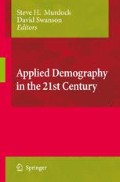Demographic changes in the population age structure are outcomes of longer life expectancies, lower birth rates, and an older average age of giving birth (see, e.g., Ram 1998, Chesnais 2001, Vaupel 2001, Becker 2004). It has been recognized that such changes are likely to result in significant increases in elder abuse (see, e.g., Ramsey-Klawsnik 2000, Voelker 2002). Specifically, disproportionate increases in the number of dependent elders relative to working age individuals may result in higher stress levels among caregivers and increase abuse opportunities, and thus may act to increase the rates of elder abuse.
Clinicians have identified a broad array of risk factors typically associated with elder abuse and neglect (for recent surveys, see Lachs and Pillemer 2004, Pillemer and Finkelhor 1989, and Podnieks 2004). Factors such as a caregiver’s mental health, substance abuse, dependence on the care recipient, and depression have been described as important indicators of elder abuse and mistreatment. Alternative theories of abuse emphasize the personal problems of the abuser (e.g., alcoholism and personality characteristics) and the personal characteristics of the elderly (e.g., poor health, limitations of daily living, social isolation) as primary factors of abuse.
Access this chapter
Tax calculation will be finalised at checkout
Purchases are for personal use only
Preview
Unable to display preview. Download preview PDF.
References
Ahn, Y.-H. and M.J. Kim (2004). Health care needs of elderly in a rural community in Korea. Public Health Nursing 21(2): 153-161.
Anetzberger, G.J., B.R. Palmisano, M. Sanders, D. Bass, C. Dayton, S. Eckert, and M. Schimer (2000). A model intervention for elder abuse and dementia. Gerontologist 40(4): 492-497.
Beach, S.R., R. Schulz, G. Williamson, L.S. Miller, M. Weiner, and C. Lance (2005). Risk factors for potentially harmful informal caregiver behavior. Journal of the American Geriatrics Society 53 (2): 255-261.
Becker, G.S. (2004). Economic approaches to understanding families. Understanding and Optimizing Human Development: From Cells to Patients to Populations 1038(1): 201-205.
Bond, C. (2004). Education and a multi-agency approach are key to addressing elder abuse. Professional Nurse 20(4): 39-41.
Borgenicht, K., E. Carty, and L.Z. Feigenbaum (1997). Community resources for frail older patients. Western Journal of Medicine 167: 291-294.
Chesnais, J.-C. (2001). Comment: A March toward Population Recession. Population and Development Review - Supplement: Global Fertility Transition 27: 255-259.
Coyne, A.C., W.E. Reichman, and L.J. Berbig (1993). The relationship between dementia and elder abuse. American Journal of Psychiatry 150(4): 643-646.
Davies, S., R. Slack, R. Laker, and I. Philip (1999). The educational preparation of staff in nursing homes: relationship with resident autonomy. Journal of Advanced Nursing 29(1): 208-217.
Dyer, C.B., V.N. Pavlik, K. Murphy, and D. Hyman (2000). The high prevalence of depression and dementia in elder abuse or neglect. Journal of the American Geriatric Society 48(2): 205-208.
Fulmer, T., G. Paveza, I. Abraham, and S. Fairchild (2000). Elder neglect assessment in the emergency department. Journal of Emergency Nursing 26(5): 436-443.
Goodridge, D.M., P. Johnston, and M. Thomson (1996). Conflict and aggression as stressors in the work environment of nursing assistants: Implications for institutional abuse. Journal of Elder Abuse and Neglect 8(1): 49-67.
Harrington, C.D., S.L. Zimmerman, J. Karon, and P. Robinson (2000). Nursing Home Staffing and Its Relationship to Deficiencies. The Journals of Gerontology Series B: Psychological Sciences and Social Sciences 55(5): S278-287.
Kleinschmidt, K.C. (1997). Elder abuse: A review. Annals of Emergency Medicine 30(4): 463-472.
Lachs, M.S. and K. Pillemer (2004). Elder abuse. Lancet 364(9441): 1263-1272.
Marquis, R., H. Freegard, and L. Hoogland (2004). Influences on positive family involvement in aged care: An ethnographic view. Contemporary Nurse 16(3): 178-186.
McCauley, J., M.W. Jenckes, and L.A. McNutt (2003). ASSERT: The effectiveness of a continuing medical education video on knowledge and attitudes about interpersonal violence. Academy of Medicine 78(5): 518-524.
Mueller, J. (2003). Service delivery to rural elderly: Creating and using a system of care. Presented to the NCOA-ASA Joint Conference, Chicago, Illinois, March 15, 2003. Available online at http://www.rupri.org/ruralHealth/presentations/mueller031503.pdf.
Payne, B.K. and R. Cikovic (1995). An empirical examination of the characteristics, consequences, and causes of elder abuse in nursing homes. Journal of Elder Abuse & Neglect 7(4): 61-74.
Pillemer, K. and D. Finkelhor (1989). Causes of elder abuse - Caregiver stress versus problem relatives. American Journal of Orthopsychiatry 59(2): 179-187.
Pillemer, K. and D.W. Moore (1989). Abuse of patients in nursing homes: Findings from a survey of staff. Gerontologist 29: 314A-320.
Pillemer, K.A. and R. Brachman-Prehn (1991). Helping and hurting: Predictors of maltreatment of patients in nursing homes. Research on Aging 13(1): 74-95.
Podnieks, E. (2004). Social exclusion: A risk factor for elder abuse. Gerontologist 44: 437-437.
Ram, R. (1998). Forty years of the life span revolution: An exploration of the roles of convergence, income, and policy. Economic Development and Cultural Change 46(4): 849-857.
Ramsey-Klawsnik, H. (2000). Elder-abuse offenders: A typology. Generations - Journal of the American Society on Aging 24(2): 17-22.
Tarbox, A.R. (1983). The elderly in nursing homes: Psychological aspects of neglect. Clinical Gerontology 1(4): 39-52.
Vaupel, J. (2001). Demographic insights into longevity. Population: An English Selection 12(1): 245-259.
Voelker, R. (2002). Elder abuse and neglect a new research topic. Journal of the American Medical Association 288(18): 2254-2256.
Woods and Poole (2004). Population Projections by Woods and Poole Economics, Inc.
Woodtli, M.A. and E.T. Breslin (2002). Violence-related content in the nursing curriculum: A follow-up national survey. Journal of Nursing Education 41(8): 340-348.
Author information
Authors and Affiliations
Editor information
Editors and Affiliations
Rights and permissions
Copyright information
© 2008 Springer Science + Business Media B.V
About this chapter
Cite this chapter
Post, L., Salmon, C., Prokhorov, A., Oehmke, J., Swierenga, S. (2008). Aging and Elder Abuse: Projections for Michigan. In: Murdock, S.H., Swanson, D.A. (eds) Applied Demography in the 21st Century. Springer, Dordrecht. https://doi.org/10.1007/978-1-4020-8329-7_6
Download citation
DOI: https://doi.org/10.1007/978-1-4020-8329-7_6
Publisher Name: Springer, Dordrecht
Print ISBN: 978-1-4020-8328-0
Online ISBN: 978-1-4020-8329-7
eBook Packages: Humanities, Social Sciences and LawSocial Sciences (R0)

